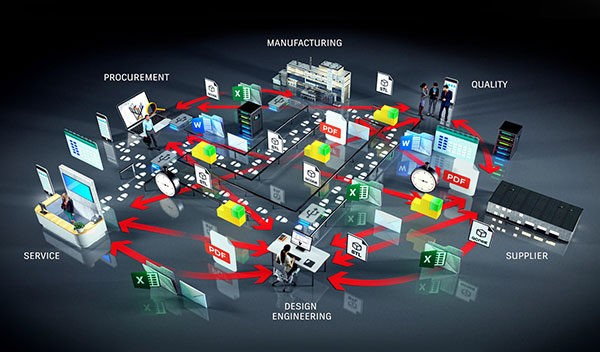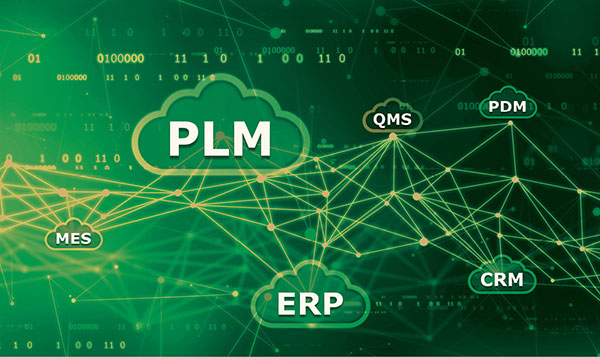Transporting PLM to the Cloud
Cloud-based PLM can provide the flexibility and accessibility needed for digital transformation.

Data as a service can simplify details and remove complex authorization chains such as who has access to what and when to simplify the ability to see the data allowed for publication, according to Razorleaf’s Jonathan Scott, chief architect.
Latest News
December 1, 2021
Business and technological conditions are at a tipping point that render traditional on-premises architectures inadequate. These software platforms simply cannot provide the integration, flexibility and accessibility that product developers now require to compete in the marketplace. Companies must either shift their product lifecycle management (PLM) processes to the cloud or fall behind more innovative businesses.
Taking this step promises to breathe new life into stalled digital transformation initiatives and help companies extract full value from big data (Fig. 1). It will also open the door to more successful implementations of emerging approaches like digital thread and digital twin.
Converging Forces of Change
Why make the move to the cloud now? What has changed since PLM systems were introduced? The answer to these questions lies in the rise and melding of market and technology forces that have emerged over the past 5 years.
First, PLM software was originally designed as a proprietary client/server solution installed at the user’s site, interacting—at least in theory—with compatible proprietary systems over internal communication infrastructures. These systems were also tailored to handle relatively small amounts of data.
Unfortunately, this architecture no longer fits well with new market dynamics. Today’s business models function very differently. The extended enterprise so prevalent now embodies an interconnected network of manufacturers, supply chain partners and customers distributed across the globe, with each element often using different authoring tools and processes.
The need to share product information with internal and external stakeholders has become essential as companies have outsourced more segments of their operations. Furthermore, dispersed development teams have become the new normal, which requires enhanced collaboration infrastructures. Product companies now needed to ensure that design partners, manufacturers and component suppliers can share information and create virtual design and manufacturing paradigms.
A big challenge to meeting this goal is to find a way to unlock crucial information now residing in proprietary design files, manufacturing systems and internal and external business data repositories. Regrettably, making this data broadly accessible to the entire enterprise economic ecosystem using traditional PLM systems has become problematic.
Today, these systems must provide a way to extract discrete, fine-grained elements from large binary files, liberating them from file formats accessible only to propriety tools and the engineers who use them. At the same time, the systems must preserve the full fidelity of the design so that individuals and functions across the entire ecosystem have easy access to, and can amend, the pieces relevant to their functions.
This task is further compounded by the enormous amounts of data being produced by Internet of Things (IoT) sources, which are increasingly tapped to create complete digital threads.
Looking to the Cloud for Software
Confronted by these issues, it has become increasingly clear to advocates and even some of the technology’s critics that the cloud offers one of the best means of delivering the kind of authorized access, concurrent collaboration, and data integration and parsing necessary to meet the market’s demands.
One of the most commonly used cloud services that promises to breathe new life into PLM platforms, software-as-a-service (SaaS) allows users to access cloud-based applications on-demand via a web browser rather than requiring them to install the software on a computer or company intranet.
The most apparent payoff of a SaaS deployment is the reduction of a company’s digital overhead. The public cloud provider manages all the hardware and traditional software, enforcing regular system upgrades and ensuring the PLM system remains up to date with the latest functionality. This allows users of the cloud service to dramatically reduce costs; deploy, scale and upgrade business software more quickly than on-premises systems; and predict total cost of ownership with greater accuracy.
There are, however, even greater benefits to be gained by adopting SaaS. For example, implementing a multi-tenant architecture, a company using a single SaaS application can support millions of users.

“Many cloud-native offerings are designed to enable an infinite network of people, organizations, data and services to work collaboratively toward a common goal or outcome,” says Brian Dueck, senior director and chief architect, PLM, at Autodesk. “Cloud-native PLM solutions naturally adapt as this network grows. These applications are designed to take full advantage of the value that a cloud infrastructure provides, such as security, flexible access, dynamic scaling of compute and storage resources, high availability and instant-on capabilities.”
Benefits of a Common Language
Complementing cloud advances in collaboration, SaaS technology enables all stakeholders to access and ingest accurate representations of the product data that they require. These cloud-native applications can exchange data with other applications in the cloud ecosystem by using a semantically and syntactically neutral language common to all cloud-native software (Fig. 2).
Because SaaS tools use a common language rather than store data in a proprietary or binary format, the software does not have to perform a translation process like legacy tools.
As more applications and processes consume and produce data expressed in the cloud-native language, it will be easier to implement powerful collaborative workflows. It also promises to enable companies to integrate unprecedented levels of data from diverse sources.
“SaaS PLM simplifies workflow automation with other solutions, creating a single source of real-time product data combined from multiple sources, including engineering, quality, sales and service,” says Dario Ambrosini, chief marketing officer at Propel.
Bridging the Language Gap
Although the common language of cloud ecosystems ensures seamless communication among SaaS applications, a disconnect remains between SaaS software and proprietary legacy applications. As a result, businesses require an effective means of facilitating data access and integration among heterogeneous software systems. This poses a significant problem because these systems represent a large portion of the software tools deployed today.
This is where data services, or data-as-a-service (DaaS), come into play. These web services consist of collections of small, independent, loosely coupled functions that automate the work of locating heterogeneously stored data, providing developers and data analysts with simple programmatic tools to find, extract and share data.
In an application, data services act as a middleware, locating and delivering information that the application requests. The inherent nature of these services makes information more accessible and comprehensible to a broad assortment of applications.
For example, in the modeling and simulation domain, PLM software providers must deal with a plethora of tools—their own, third parties’ and client-built custom modeling tools.
“Unfortunately, most companies have limited to no governance to drive the consistency needed to feed this data into the PLM applications,” says Loren Welch, director of design and manufacturing strategy at Autodesk. “To solve this problem, companies are increasingly turning to a distinct data services layer, which acts as a translator between the PLM platforms and the tools themselves.”
Some DaaS information models can even expand data accessibility by allowing multiple users to work concurrently on a design by breaking up the body of information into smaller pieces (for example, one person works on the bill of materials while another works on the CAD files).
DaaS also provides companies with a way to better deal with the increasing amounts of data generated by the IoT.
“As companies require an increasing amount of internal and external data to enhance their current data models and digital threads, DaaS can help them offload the collection, management and storage of high volumes of data by outsourcing these operations to third-party vendors,” says Bruce Bookbinder, product marketing manager at Aras.
Right Data for the Right Person
DaaS takes the drive to enhance accessibility and collaboration one step further by providing data that meets the needs of specific people, processes and applications. These cloud services can be used to abstract raw data from a PLM platform’s sources and apply governance principles and provide targeted data to individual users.
Abstraction is done at the syntactic and the semantic level. Syntactic abstraction normalizes data representation and hides complexities of how to access individual data sources. Semantic abstraction renders information in a normalized, source-independent model that provides a reliable foundation for solutions to be built independent of the specific data sources in a particular deployment target.
Software developers can use this feature of DaaS to enhance and customize SaaS applications.
“DaaS abstractions facilitate rapid creation and the evolution of SaaS-based solutions that cater to the many roles involved in the product lifecycle without affecting the underlying standardized offerings,” says Dave Duncan, vice president of product management at PTC. “DaaS can also serve custom applications, enabling an ecosystem of SaaS solution builders with expertise in a specific facet of the product life cycle to create a spectrum of solutions based on the standardized model offered by DaaS.”
Abstraction can also play an important part in Big Data strategies because it can make sense of massive collections of structured, semi-structured and unstructured data stored in various sources.
“Data becomes most useful—has the greatest potential to yield valuable information and actionable insights—when it’s in its purest, most granular, unlocked form,” says Autodesk’s Dueck. “This enables it to be ingested, analyzed, added to and leveraged by the broadest spectrum of tools and processes.
“The idea of creating a common data model in the cloud means that files are broken down into discrete data elements,” Dueck adds. “Then that data, as well as insights derived from it using cloud-based AI, is provided to the people and functions that become more efficient when they have that information.”
To better understand the concept, imagine an engineer has designed an assembly that includes four nuts and four bolts. The design specifies the geometry, material, mating conditions and load requirements of the hardware.
Individual details about that hardware must be available for consideration by multiple functions across the organization. Not everyone, however, wants to know the same things about the nuts and bolts.
For example, procurement wants to know part numbers, quantities and material. Manufacturing needs to know exact details about the parts, such as clearances for assembly tools, dimensions and torque specifications to tool up and assemble the product correctly. Shipping needs to know the weight of the final product to determine shipping costs.
DaaS-enabled cloud-based systems understand who needs what and when, so that they can deliver the data—and only the information that’s relevant—to the function or user making the request. Further, the web service ensures that the data is extracted from the current, live design and is delivered to authorized recipients upon request.
“Many domain-specific tools, like PLM and other engineering-centric tools, have highly specialized data models that delineate the nuances of a data set,” says Jonathan Scott, chief architect at Razorleaf. “For example, PLM might understand that a component is a configuration or variant of another component, but someone consuming a data service of a company’s item catalog does not care about this detail. DaaS can simplify these details and remove complex authorization chains—who has access to what and when—to make it easier to see the data allowed for publication.”
True Nature of PLM in the Cloud
What qualifications determine whether a PLM application is cloud based? If you take an on-premises application and transplant it to the cloud, does that fit the bill? There is no industry consensus on this question.
Some companies take a broad view.
“SaaS PLM in the cloud can be either native-cloud applications or on-premises applications moved to the cloud,” says Justin DiNunzio, marketing manager at Siemens Digital Industries Software. “I view SaaS as a licensing model, while PLM in the cloud can be viewed through the lens of ‘operated by the PLM vendor’ or ‘operated by the end-user organization.’”
Others, however, take a narrower view.
“On-prem applications that have simply been transplanted to the cloud are just that: single-user or single-department software running on someone else’s rented compute, storage and network infrastructure,” says Dueck. “Cloud-native applications, on the other hand, are built from inception to leverage the value that comes from near-universal log-in, authentication and collaboration capabilities, the benefits that come from near-infinite computing power and storage at one’s fingertips, when needed.”
Despite these differing perspectives, all agree that the cloud has the potential to deliver an impressive array of benefits to PLM deployments and digital thread/twin implementations.
More Aras Coverage
More Autodesk Coverage
More PTC Coverage
Subscribe to our FREE magazine, FREE email newsletters or both!
Latest News







